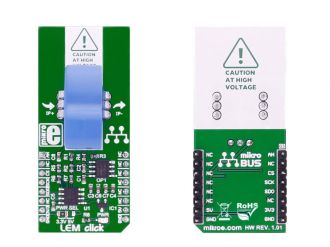
We strongly encourage users to use Package manager for sharing their code on Libstock website, because it boosts your efficiency and leaves the end user with no room for error. [more info]

Rating:
Author: MIKROE
Last Updated: 2019-05-03
Package Version: 1.0.0.1
mikroSDK Library: 1.0.0.0
Category: Measurements
Downloaded: 7058 times
Not followed.
License: MIT license
LEM click carries the LTS 6-NP current transducer and MCP3201 ADC converter. The click can measure AC and DC current with exceptional speed, up to 200 KHz. LEM click is designed to run on either 3.3V or 5V power supply. It communicates with the target microcontroller over SPI interface.
Do you want to subscribe in order to receive notifications regarding "LEM click" changes.
Do you want to unsubscribe in order to stop receiving notifications regarding "LEM click" changes.
Do you want to report abuse regarding "LEM click".


Library Description
The library covers all the necessary functions that enables the usage of the LEM click board.It offers reading from output register and calculations that result in relatively accurate measurement of current passing through the conductor in amperes and milliamperes.
Key functions:
uint16_t lem_dataRead() - Function is used to read data from output register.float lem_getCurrentAmps() - Function is used to read current in amperes.float lem_getCurrentMilliAmps() - Function is used to read current in milliamperes.Examples description
The application is composed of the three sections :
void applicationTask( )
{
current = lem_getCurrentMilliAmps();
mikrobus_logWrite( "Current in milliamperes: ", _LOG_TEXT );
FloatToStr( current, logTxt );
mikrobus_logWrite( logTxt, _LOG_TEXT );
mikrobus_logWrite( "mA", _LOG_LINE );
Delay_ms( 1000 );
mikrobus_logWrite( "-----------------------", _LOG_LINE );
}
Other mikroE Libraries used in the example:
SPIUARTConversionsAdditional notes and informations
Depending on the development board you are using, you may need USB UART click, USB UART 2 click or RS232 click to connect to your PC, for development systems with no UART to USB interface available on the board. The terminal available in all MikroElektronika compilers, or any other terminal application of your choice, can be used to read the message.